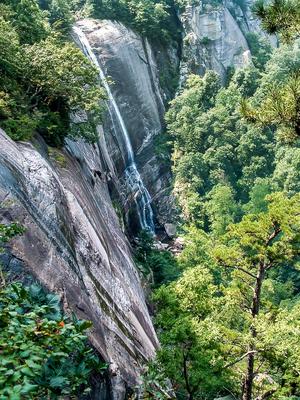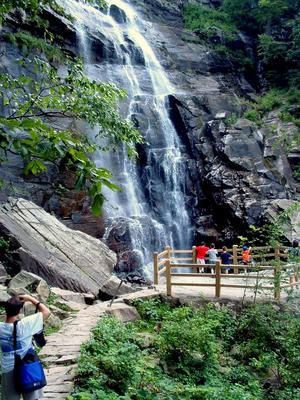Hickory Nut Falls
At A Glance
TODO: #32 Boilerplate

1.5 mi round-trip
Difficulty Rating: 2.0 ![]()
Climb: Climbs Gently ![]()
Tread Condition: Some Obstacles ![]()
Highest Elevation: 1900 ft
Climb Total: 200 ft
Configuration: Out-and-back
Starting Point: Lower parking area at Chimney Rock Park
Trails Used: TODO dynamic list Hickory Nut Fallsl
Note: There is a fee to enter Chimney Rock Park. Get more information on the park's web site.
Hickory Nut Falls is not only one of the tallest waterfalls in the region, but it was arguably made more notable by its appearance in the movie The Last of the Mohicans. Formerly called the "Forest Stroll" trail, the path leading to its base has been more aptly named the Hickory Nut Falls trail since the park came under state ownership. And that's good, since the waterfall is the trail's main destination - and one of the top destinations in the park!

That's not to say Forest Stroll was a totally inappropriate moniker, though, since that's what the hike to the falls entails. You'll enjoy walking through the mixed hardwood forest along almost the entire route.
Shortly after heading under the entrance sign and gate, you'll reach the intersection with the Outcroppings trail on the left, which takes the form of a sturdy, elaborate set of stairs (newly reconstructed in 2012). That "trail" goes up toward the main parking area and the Chimney. Keep straight on the Hickory Nut Falls trail.
Next you'll reach the Four Seasons trail which descends a set of steps on the right. As its name indicates, the trail is open all year long and can be used as a longer route to get to Hickory Nut Falls from the Meadows area. Keep straight again here.
Passing through the next gate puts you solidly on the path to the base of the falls. There are no other intersections beyond the second gate.
Although the trail is not difficult, there are a couple of moderate climbs and at times the surface is quite rocky. Signs along the route explain various points of interest and depict the ecology of the environment through which you are traveling. Various plants are introduced and aspects of the geography are discussed, and there are plenty of wildflowers to be found, admired, and photographed (but not picked!) during the growing season.

One sign depicts a deep erosion gully as a natural factor in the shaping of this mountain. In general, it's true that erosion has resulted in nearly all of the topography we see today in the southern Appalachians. At the gully in question, however, it appears that when the old road which now forms this trail was cut in, it greatly exacerbated the rate of erosion on the uphill side, making this particular gully a somewhat man-made phenomenon. Nevertheless, this is an interesting spot with the deep, rocky ravine reaching right up to the base of the sheer rock cliffs looming above you.
You can see plenty more evidence of how erosion factors into the creation of the surrounding topography. During a heavy rainstorm some years back, a major section of the trail slid away and a huge, beefy bridge was built to replace it. The bridge is sturdy and wide and can easily carry a loaded pickup truck. Just beyond the bridge, you'll round a small ridge, where you'll be near the base of the falls and begin to hear them.
The trail ends in a paved area with a picnic table, and a narrower path heads left up a set of steps to a viewing area at the base of the falls. It is relatively safe to rock-hop and explore the stream right at the base of the falls since it is flat there, but it is generally frowned upon and signs will admonish your decision if you do that. So stay very close to the base of the falls, since the stream has more tall cascades below the small flat area.
Once you're done exploring and marveling at the falls and huge cliff walls, return to your vehicle on the same path.

